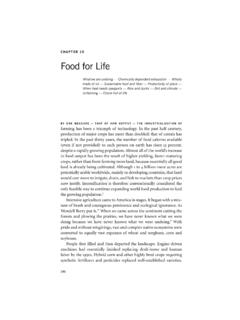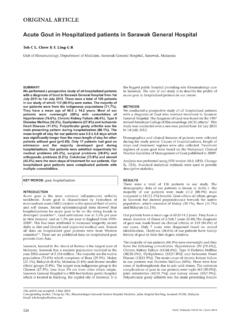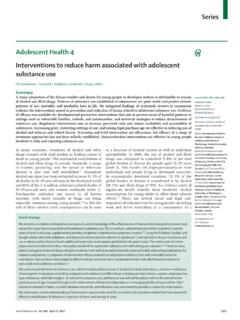Transcription of CHAPTER 11 1 Aqueous Solutions - natcap.org
1 1234567891011121314151617181920212223242 526272829303132333435363738 S39 RCHAPTER 11 Aqueous SolutionsDrilling to China More water than rivers Saving the aquifer Drying with Xeriscapes Everywhere in the house Rainwater andgraywater Creating urban watersheds Wastewater equalsfood Watering the communityWE LIVE ON THE WATER PLANET. THREE-FOURTHS OF THE EARTH S SURFACEis covered by water. Yet fresh, clean water is scarce and getting more all the water on earth, less than 3percent is fresh, and all but three-thousandths1of that is locked up in glaciers and icecaps or is too deep inthe earth to retrieve. The freshwater available in rivers, lakes, and acces-sible groundwater is increasingly nearly 200,000square miles of reservoirs to store more than 1,400cubic miles ofwater a redistribution of natural flows that has measurably changedthe orbital characteristics of the planet3 even whole cities the size ofMexico City are steadily becoming shorter of water, and water scarcityhas changed global patterns of grain the land s water-holdinggreen skin changes to water-losing brown scabs, water tables are retreat-ing on every continent, with 70percent of the pumping to irrigate s water table is retreating toward the People s Republic, whileBeijing s water table is getting closer to the United conse-quences are not merely local.
2 Water is becoming a significant cause ofinternational make matters worse, global climate changecould intensify the droughts that have sporadically devastated anddesertified subcontinental answer to decreasing supplies of freshwater is not to try to sup-ply beings already use one-fourth of the earth s totalwater in natural circulation, and over half of the accessible dams might modestly increase available runoff but are costly andenvironmentally damaging. Even if most of the good sites had notalready been taken long ago, no supply strategy could keep pace withthe present rate of population growth and population213214 NATURAL CAPITALISM123456789101112131415161718192 02122232425262728293031323334353637S38R3 9will probably increase 45percent in the next thirty years, increases inaccessible runoff are projected to be only 10percent.
3 Even after invest-ing some $400billion in water supply over the past century,11theUnited States, with all its wealth and technical prowess, faces shortagesthat have no easy remedies. As one authority put it in 1984, The watersupply of the West is nearly fully utilized. It is difficult to see major con-struction projects which will add significantly to the current supply. 12 Moreover, America s eighty thousand dams and reservoirs were notentirely benign: During the boom years of water-capturing projects,the United States lost over 60percent of its inland wetlands, pollutedhalf its stream-miles, and lost or badly degraded many major home and abroad, with water as with energy, the only practi-cal, large-scale solution is to use what we have far more , especially industrialized, countries, still make all the samemistakes with water that they made with deplete nonre-newable supplies and seek more water instead of using inexhaustiblesources more productively and enhancing their capture by restorativegrazing, farming, and forestry.
4 They rely on the highest-quality waterfor every task, flushing toilets and washing driveways with drinkingwater. They build big dams and water projects by reflex, rather thanasking what s the best solution and the right size for the , this mind-set is changing. A host of available andemerging techniques is making it possible to increase radically the pro-ductivity of water directly where it s used. These technologies and man-agement methods, and new ways to implement and reward them, canenable countries to deliver worldwide on South Africa s water-policypromise, Some, for all, for ever. These breakthroughs come none toosoon. All the water that can reasonably be obtained will be needed tofeed the world in the coming century while protecting the natural capi-tal on which all life DRYA griculture is responsible for about twice as much of total waterwithdrawals as all buildings, industry, and mining combined.
5 Itaccounted for 81percent of all 1995consumptive use. Eighty-eight per-cent of the nation s 1995irrigation water went to 17western states,where the great majority of all water districts were mining groundwaterfaster than it was being recharged. This is a long-standing flows from rivers are provided to agriculture under a pro-215 Aqueous SOLUTIONS1234567891011121314151617181920 212223242526272829303132333435363738 S39 Rgram of federal subsidies that go back to the nineteenth century. Cali-fornia has built a vast agribusiness sector on water so heavily subsidizedthat 57percent of its agricultural water grows four crops that produceonly 17percent of its agricultural has long used sub-sidized water to flood-irrigate cotton and alfalfa in a desert. The statesalong the Colorado River, including five of the ten fastest-growingstates in the United States, have already allocated on paper more waterthan is actually in the river, and in many years, the river never reachesthe gargantuan water projects have failed to pass the giggle Army Corps of Engineers wanted to pump the Missouri Riveruphill to recharge aquifers in and beyond west Kansas, even thoughthere was no legal crop that farmers could grow with that water to earnenough to afford the pumping 1968 Texas Water Planwould have needed seven Chernobyl-sized power plants to pump waterabout 3,000feet up from the Mississippi River to a region of west ultimate wet dream, the North American Water and PowerAlliance, would have replumbed western North America.
6 It proposed todam the 500-mile-long Rocky Mountain Trench near Banff and JasperNational Parks, and to divert the major rivers of Alaska, the Yukon, andBritish Columbia to supply water to all of Canada, the western and mid-western United States (pumping over the Rockies as needed), andnorthern Mexico. This massive project, which was ultimately killed,would have cost the best part of a trillion dollars. Proposed with astraight face, this plan was the ultimate expression of how far somepeople are willing to go to put water where it isn America s High Plains, extending from north Texas to theDakotas, lies the Ogallala Aquifer, a deposit of Pleistocene groundwaterspanning an area larger than California. By 1990, it was being drawndown at a rate of3to 10feet a year to provide 30percent of America sgroundwater-based at a rate of less than a halfinch per year, parts of the aquifer were getting badly depleted; half totwo-thirds of the economically recoverable Texas portion was alreadydrained by , two-fifths of America s feedlot cattlewere being fed grain made of Ogallala groundwater.
7 Growing enoughof that grain to add sufficient weight on a feedlot steer to put an extrapound of beef on the table consumed up to a hundred pounds of lost,eroded topsoil and over eight thousand pounds of Ice Age CAPITALISM123456789101112131415161718192 02122232425262728293031323334353637S38R3 9 The initial water rush that dotted the High Plains with center-pivot irrigation (those are the circular areas of irrigated land you seewhen flying across the country) from the 1950s to the 1980s presumedthat water resources were inexhaustible. A study of High Plains farmersand ranchers found that only half had adopted as many as three ofthirty-nine available irrigation-efficiency the early 1990s,depletion and pumping costs had forced hard-hit towns to rediscoverdryland farming. Some, like Hays, Kansas, where water was consideredabundant twenty years ago, are now turning toward water efficiency fortheir very the problem is not just whether the ground-water exists but also whether one can afford to pump it to the on increasingly scarce supplies is not limited to agri-culture: Providing water to Las Vegas has become a regional drop that can be saved, bought, borrowed, or otherwise appro-priated from other areas in Nevada or the rest of the West is used to fuelthe city s subsidized sprawl, creating, in effect, a second Los Angeles in acountry that has one too many.
8 Even in the rainy eastern states, mostcities, even those with relatively static populations, have recently suf-fered water EFFICIENCY SOLUTIONThe combination of dwindling federal water subsidies, the end of thebig-dam era, energy and environmental constraints, and growing pop-ulation and economic-growth pressures is creating a future of scarcerand costlier water, even in a country as rich in available water, money,and technology as the United States. Fortunately, demand-side solu-tions are emerging that can not only avert most water shortages but, asin the case of energy, turn deficits into unnoticed by nonspecialists, and in a radical deviation fromthe beliefs and experiences of water planners,23 American farmers,landscapers, building operators, industrial engineers, and communitiesare making impressive progress in using water more productively.
9 Thegraph opposite24shows that in all sectors especially agriculture,industry, and power generation the overall efficiency of water usehas been improving since about 1980. Even as the population and theeconomy grew, the amount of freshwater withdrawn per American fellby 21percent during the years 1980 95, and water withdrawn per dollarof real GDP fell by a startling 38percent over twice as fast as energyefficiency SOLUTIONS1234567891011121314151617181920 212223242526272829303132333435363738 S39 RThis success is starting to be mirrored worldwide :1995world waterwithdrawals were only about half what planners had predicted thirtyyears earlier by extrapolating historical this is only thebeginning. In every sector and every society, far larger opportunitiesbeckon for saving water, money, and natural is more cost-conscious than an informed farmer.
10 As WayneWyatt, manager of the High Plains Underground Water ConservationDistrict in Lubbock, Texas, said, The nerve to the hip pocket is mightysensitive. Farmers in his district are starting to water their crops onlywhen they need it, rather than on a regular schedule. A common tech-nique uses a one-dollar block of gypsum, the size of a lump of sugar,buried at the root zone. Wires embedded in the gypsum run back up tothe surface to a clip-on meter that indicates soil moisture. In manyareas, such readings are saving one-third to two-thirds of the waterwith no change in crop yields, and are allowing farmers both to distrib-ute water more evenly across a field and to schedule irrigation more450400350300250200150100500765432101 95519601965197019751980198519901995billi ons of gallons per day, or million peopleGDP in trillions, 1992 dollarsPopulationGDPrural domestic and livestockpublic supplymining, industrial, and commercialirrigationthermoelectric power218 NATURAL CAPITALISM123456789101112131415161718192 02122232425262728293031323334353637S38R3 9efficiently.











